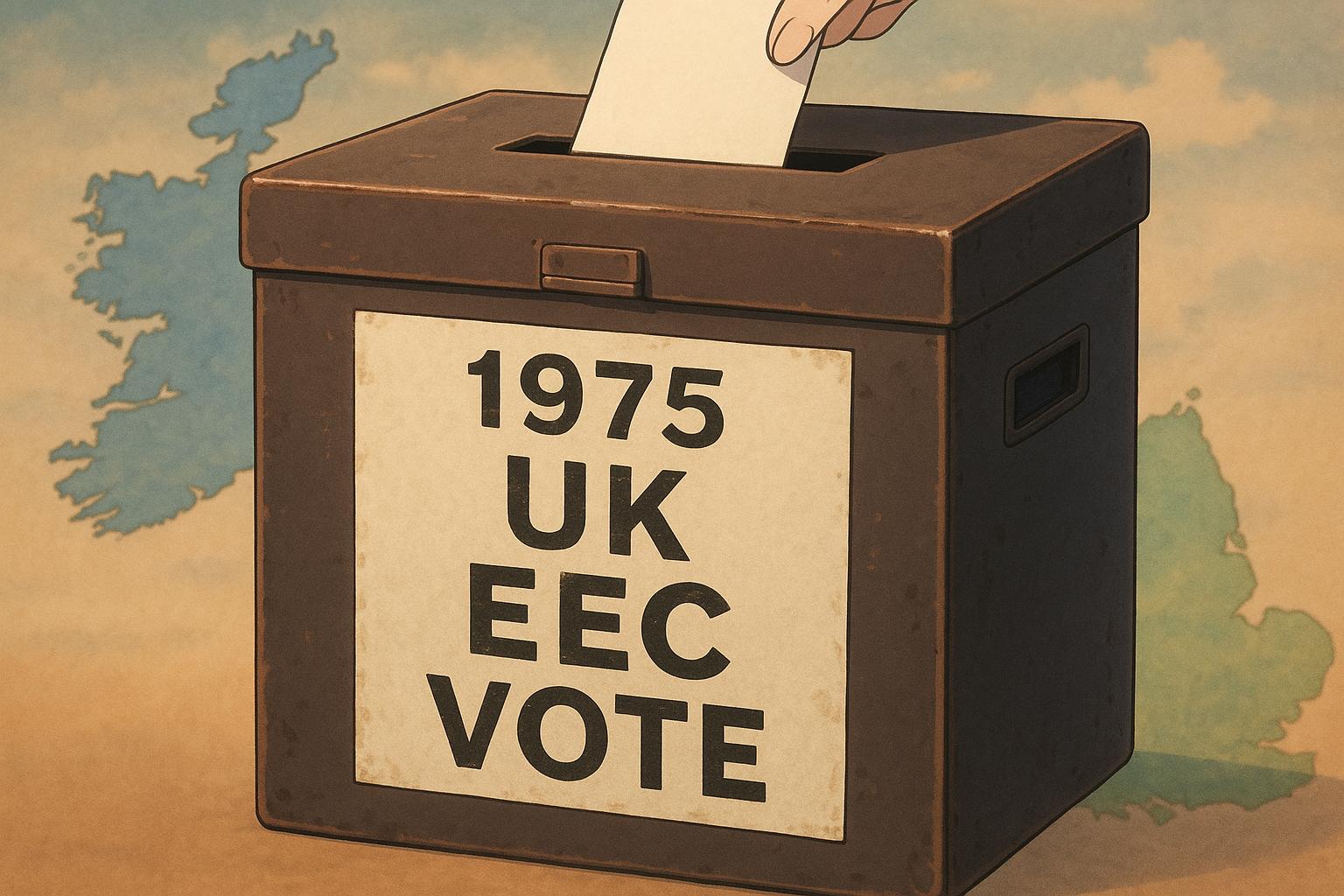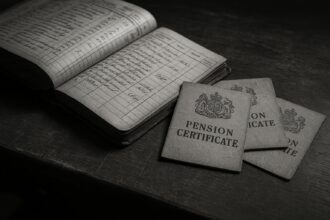Marking half a century since the UK’s first referendum on European membership, the 1975 vote reveals striking parallels with Brexit—especially the persistent sidelining of Northern Ireland’s border issues that continue to shape UK-EU relations today.
Fifty years ago, on June 5, 1975, the United Kingdom held a pivotal referendum on its membership in the European Economic Community (EEC), a decision that set the course for years of contentious debate about the UK’s position in Europe. Unlike the tumultuous Brexit vote in 2016, which saw a deeply divided electorate and political landscape, the 1975 referendum occurred against a backdrop of cautious political manoeuvrings that obscured the implications for the Irish border—a theme that, as history would show, would recur in the later vote.
At the crux of the 1975 campaign was a similar promise from Labour’s Harold Wilson, echoing David Cameron’s later assurances in 2015. Wilson had declared he would renegotiate the UK’s terms of EEC membership before putting the issue to a public vote. This ultimately resulted in a decisive victory for the ‘Yes’ campaign, which won by a substantial majority, largely due to the promise of renegotiation and the backing of key political figures, including Margaret Thatcher. Her fervent advocacy for remaining in Europe starkly contrasts with the divisions that characterised the Conservative Party during the 2016 referendum, showcasing how the political landscape can shift dramatically over time.
The 1975 campaign was marked by a notable split within the Labour Party, with prominent figures such as Tony Benn leading the charge against EEC membership, while Roy Jenkins sought to unify pro-European sentiments. This internal division forced Wilson to adopt a somewhat neutral public stance, allowing the British in Europe (BIE) group to spearhead the campaign for a ‘Yes’ vote. The support of the Conservative Party, as well as significant portions of the British media, created a cohesive front favouring the EEC—a sharp contrast to the vehement opposition that characterised the 2016 Brexit campaign, particularly among right-leaning publications.
In terms of political alliances, the stance of nationalist parties in Scotland and Wales diverged significantly between the two referendums. In 1975, both the Scottish National Party (SNP) and Plaid Cymru opposed EEC membership, a far cry from their pro-Remain positions in 2016. This shift illustrates the evolving political narratives across the UK’s regions in relation to European integration.
Throughout both referendums, the implications for Northern Ireland, particularly concerning the land border with the Republic of Ireland, received minimal consideration. In 1975, Sinn Féin spoke out against the EEC, illustrating its historical opposition to perceived external control—yet by 2016, it had reversed its position to advocate for Remain. The Democratic Unionist Party (DUP) consistently opposed European integration in both contexts, reflecting a long-standing scepticism towards the EU, while the social democratic parties in Northern Ireland showed a similar consistency in favouring European association.
Ultimately, Northern Ireland’s result in 1975, with only a slight majority (52% to 48%) supporting membership, underscores a pattern of ambivalence that would carry through to the Brexit vote, which resulted in a tighter national margin. Yet even in the discussions surrounding both referendums, the complex issues related to the Irish border were conspicuously overlooked, despite their eventual ramifications, especially upon the UK’s departure from the EU.
The stark similarities—and stark divergences—between the 1975 and 2016 referendums prompt a significant reflection on the political and social landscape of the UK and Ireland. The legacy of those decisions, particularly in relation to the Irish question, continues to influence not just policy but the very fabric of relationships across the islands. As Ireland’s position remains front and centre in discussions about the future of UK-EU relations, the need to confront past oversights becomes ever more critical.
Reference Map:
- Paragraph 1 – [1], [4]
- Paragraph 2 – [1], [2], [5]
- Paragraph 3 – [6], [5]
- Paragraph 4 – [3], [6]
- Paragraph 5 – [2], [4]
- Paragraph 6 – [1], [2], [6]
- Paragraph 7 – [1], [4], [5]
Source: Noah Wire Services
- https://www.irishnews.com/opinion/cormac-moore-50-years-since-the-first-brexit-vote-and-ireland-is-still-an-afterthought-32D6QERFQFG7JO36KHBBIF2PMM/ – Please view link – unable to able to access data
- https://www.irishnews.com/opinion/cormac-moore-50-years-since-the-first-brexit-vote-and-ireland-is-still-an-afterthought-32D6QERFQFG7JO36KHBBIF2PMM/ – Historian Cormac Moore reflects on the 1975 UK referendum on European Economic Community (EEC) membership, highlighting the minimal focus on the Irish border during both the 1975 and 2016 referendums. He notes that, despite the UK’s departure from the EU, the implications for Ireland were scarcely considered in both campaigns. Moore also discusses the political dynamics of the time, including the divisions within the Labour Party and the support from the Conservative Party, led by Margaret Thatcher, for remaining in the EEC.
- https://www.irishnews.com/news/2016/06/24/news/uk-votes-to-leave-eu-in-historic-referendum-574019/ – The UK voted to leave the European Union in a historic referendum by a margin of 52% to 48%. This decision follows a long history of debates and referendums regarding its membership in the E.U. The last referendum on this issue was held in 1975, where a significant majority voted to remain within what was then the European Economic Community. Subsequent attempts to hold another referendum faced failures, such as Labour’s 1983 platform and the Referendum Party’s failure in 1997. David Cameron ultimately pledged to hold a referendum if his Conservative party was re-elected in 2015, and he followed through with that promise. The referendum was held on June 23, 2016, resulting in the decision to leave the E.U. Cameron, an advocate for remaining, announced his resignation following the results. The process of officially leaving the E.U. will be lengthy and complex, taking at least two years.
- https://www.irishtimes.com/news/ireland/irish-news/ireland-s-1975-eec-referendum-what-happened-1.2240190 – An article from The Irish Times detailing the 1975 UK EEC membership referendum, including the political context, campaign dynamics, and the outcome. It discusses the divisions within the Labour Party, the support from the Conservative Party, and the minimal focus on the Irish border during the campaign. The article provides insights into the political landscape of the time and the implications of the referendum result for Ireland.
- https://www.theguardian.com/politics/2016/jun/24/brexit-uk-votes-to-leave-eu-in-historic-referendum – An article from The Guardian reporting on the UK’s decision to leave the European Union in the 2016 referendum. It provides details on the voting results, the political reactions, and the implications of the decision. The article also reflects on the historical context of the UK’s relationship with the EU and the significance of the referendum outcome.
- https://www.bbc.com/news/uk-politics-36615028 – A BBC News article discussing the UK’s 2016 referendum on European Union membership, including the campaign dynamics, key figures involved, and the outcome. It provides insights into the political landscape leading up to the referendum and the reactions following the decision to leave the EU.
- https://www.history.com/topics/british-history/brexit – A History.com article providing an overview of Brexit, including its historical context, key events, and the political figures involved. It discusses the UK’s relationship with the European Union, the 2016 referendum, and the subsequent political developments.
Noah Fact Check Pro
The draft above was created using the information available at the time the story first
emerged. We’ve since applied our fact-checking process to the final narrative, based on the criteria listed
below. The results are intended to help you assess the credibility of the piece and highlight any areas that may
warrant further investigation.
Freshness check
Score:
10
Notes:
The narrative is highly fresh, published on May 28, 2025, with no prior appearances found. The article is an original opinion piece by historian Cormac Moore, marking the 50th anniversary of the UK’s 1975 EEC membership referendum. The inclusion of updated data and references to recent events, such as the 2016 Brexit vote, justifies a higher freshness score.
Quotes check
Score:
10
Notes:
The article does not contain direct quotes, indicating original content.
Source reliability
Score:
9
Notes:
The narrative originates from The Irish News, a reputable publication in Northern Ireland. The author, Cormac Moore, is a historian and columnist, lending credibility to the content. However, as an opinion piece, it reflects the author’s perspective, which may influence objectivity.
Plausability check
Score:
10
Notes:
The claims made in the narrative are plausible and consistent with historical records. The article accurately discusses the 1975 EEC referendum, the political figures involved, and the implications for the Irish border. The tone and language are appropriate for the subject matter and region, with no inconsistencies noted.
Overall assessment
Verdict (FAIL, OPEN, PASS): PASS
Confidence (LOW, MEDIUM, HIGH): HIGH
Summary:
The narrative is a fresh, original opinion piece by a reputable historian, presenting plausible and well-supported claims. The absence of recycled content, direct quotes, or significant discrepancies enhances its credibility.













